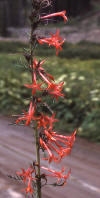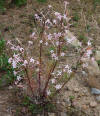|
Ipomopsis aggregata |
Ipomopsis aggregata |
|
Rocky Mountains, Colorado.
August1979. Pick-up load (recollection) of scarlet gilia collected by
Richard Spjut in Colorado for isolation of antitumor agents. Ipomopsis tenuituba Nevada. Humboldt-Toiyabe NF: Mountain City District: west slopes of Independence Range, Jack Creek along FR Rd 732; 41º31.039, 116º03.419, 6500 ft. Riparian aspen and willow (75%), and elderberry (25%) community along creek with with high density (100%) stands of Veratrum californicum bordered by open meadows with sedges, grasses, Dasiphora fruticosa. 27 July 2010
|
Ipomopsis longiflora
|
|
Arisawa M., S. Funayama, J. M. Pezzuto, A. D. Kinghorn, G. A. Cordell and N. R.. Farnsworth. 1984. Potential anticancer agents XXXII. Hydroquinone from Ipomopsis aggregata. J. Nat. Prod. 47(2): 393–394.
Arisawa M., S.
Funayama, J. M. Pezzuto, A. D. Kinghorn, G. A. Cordell and N. R..
Farnsworth. 1984.
Plant
anticancer agents. XXX: Cucurbitacins from Ipomopsis aggregata (Polemoniaceae).
J. Pharm. Sci. 73(3): 411–413. “Isocucurbitacin B (I),
3-epi-isocucurbitacin B (II), and cucurbitacin B (III) were identified as
the principal cytotoxic constituents of Ipomopsis aggregata (Pursh)
V. Grant (Polemoniaceae). The structure of the new compound, II, was
determined through analysis of its spectrometric characteristics.” |
|








